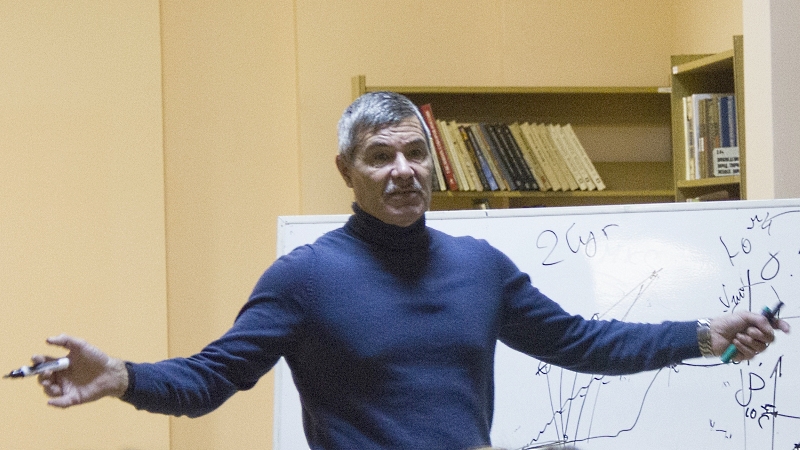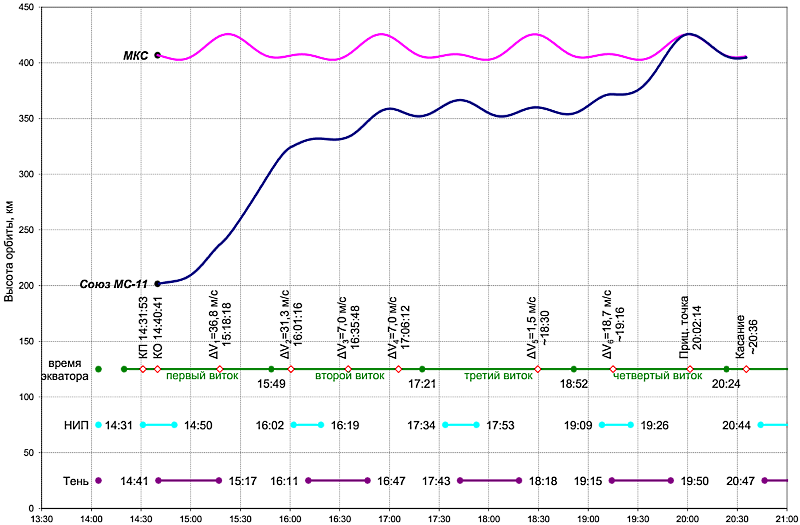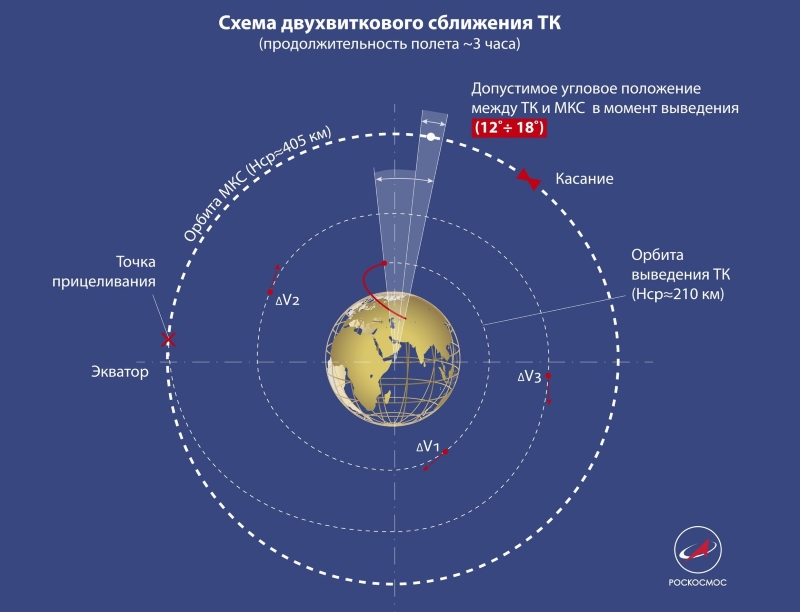Record "Progress MS-11": the most interesting to come
Last week, the Progress MS-11 cargo ship set a new record, docking with the ISS after 3 hours and 21 minutes after launch. This is the second ship that flew over an ultrashort circuit - just two turns. Since 2012, when the Progress M-16M flew in a short six-hour scheme, the flight time to the ISS is shrinking, and the three-hour reached now is not the limit.

Start of the cargo ship, photo by the Yuzhny center / Roscosmos

A. Sokolov. First experimental space station (docking of Soyuz-4 and -5 spacecraft)
A slight historical irony is that the first connections were quick. The absolute speed record belongs to the USSR - on April 15, 1968, the unmanned Soyuz, called the Cosmos-213, docked to the same type Cosmos-212 just 47 minutes after the start. Record manned docking could also become Soviet - Soyuz-3, which was piloted by Georgy Beregovoi, became close to the unmanned Soyuz-2 in less than an hour. But, alas, the astronaut could not orient the ship correctly on the night side of the orbit, and the docking failed. So the record for manned docking speed belongs to the Americans. Launched in September 1966, Gemini-11 docked with the Agen target after 1 hour and 34 minutes.
')
Now such records can not be surpassed, and the reason lies in the orbital mechanics. In the USSR, at the Baikonur cosmodrome there were two launch sites, and it was possible to launch the first ship into orbit, which in a day would pass over the cosmodrome. At this point, the second ship launched, which immediately turned out to be close to the first. For the first time, such a focus was turned with “Vostokami” -3 and -4, and cosmonauts Nikolaev and Popovich were at a distance of direct visibility from each other. In the United States to the east of the cosmodrome, there was an ocean that allowed a second ship to be launched into the same orbit as the first, twice a day, in an ascending and descending segment of the orbit. In any case, the launched second ship was at a distance of several kilometers from the target and could immediately proceed to docking.

Station "Salyut-7" and docked ship "Soyuz"
When the operation of orbital stations began, these schemes stopped working due to the fact that the stations were launched to higher orbits, slowed down with time, and the Soviet ones also maneuvered on their own. As a result, the USSR and the USA went their separate ways. In the US, flights to the Skylab station took 6 turns or 8.5 hours. In the USSR, switched to the daily scheme. The station performed a maneuver, preparing its orbit to receive the ship, which flew for about 24 hours. When the Mir orbital complex was launched in the mid-80s, it turned out to be too heavy for a special maneuver, so the ships switched to a two-night approach scheme. This was also influenced by another factor - as practice showed, a day after the start, the astronauts were acutely experiencing an adaptation to weightlessness, they felt worse, and, if necessary, switching to manual docking functioned less efficiently and made mistakes. The two-day docking scheme began to be used on the ISS, and before the beginning of the tenth years both cargo and manned spacecraft reached the station in 34 turns.
By the beginning of the tenths, the transition to digital control systems on ships and launch vehicles made it possible to begin experiments with faster docking schemes. In RSC Energia, Rafail Farvazovich Murtazin, who has worked in the ballistics department since 1979 and is now the head of the department, became the main enthusiast.

R.F. Murtazin, photo by Vera Tyukalova / “Your sector of space”
But what is the duration to go? History has shown that the daily pattern is not optimal. In general, according to doctors and astronauts, an acute period of adaptation to weightlessness begins after about six hours in space. The second limitation was set by the technician - after the fifth orbit, the orbit shifts relative to ground measuring points, and it becomes much more difficult to steer the ship. Initially, a five-turn scheme was developed, but it turned out that, due to the peculiarities of the control, it could not be preliminarily checked on a cargo ship. So, it was four turns or six hours that became the maximum allowed for the short circuit. Moreover, the technique should be working constantly, the record for the record does not make sense. And for this it was necessary to learn how to solve technical and ballistic problems. The ISS is the heaviest station ever to exist, and the possibilities for its maneuver to form the required orbit are very limited. It is also large, with huge solar panels, and noticeably inhibited by the remnants of the atmosphere. And the density of these residues depends on solar activity, which cannot be predicted for months in advance. In addition, sometimes you have to perform maneuvers to evade space debris. There are technical limitations - the docking should be done on the day side of the orbit and in the zone of visibility of ground control points. And finally, you need to keep the parameters of the orbit compatible with future launches.
The main parameter that determines the possibility of docking is the phase angle and its allowable range. When the Soyuz or Progress is separated from the third stage of the launch vehicle, they are in a low orbit at an altitude of about 210 km. ISS flies higher at 400-450 km. To fly to the station, the ship must raise its orbit and aim at the point where the station will be after some time. Therefore, at the time of separation between the ship and the station there is a so-called phase angle (in the figure, the bright sector).

The phase angle has an acceptable phase range. For a two-night scheme, it was just huge - 150 °. And in the four-turn scheme, it turned out to be much less - 22 degrees (phase angle from 18 ° to 40 °). And then I had to use technical tricks, for example, the ship performs the first two maneuvers in autonomous mode, relying on the calculated, rather than the real situation. In subsequent maneuvers, when the elimination error became known, a correction was performed. Without this trick, the phase range would fall to about 15 degrees, and it would be extremely difficult to stack an uneven and unpredictable station in it.

Maneuvers and orbit altitude of the Soyuz MS-11 spacecraft, source
The first manned "Soyuz" went to the station on a short circuit in 2013, and the crew appreciated the convenience of innovation. But it was not perfect either - the astronauts have a very long working day, 18-20 hours, of which 11 have to be carried out in space suits. There was an obvious desire to reduce the time from start to docking even more. But the shorter the flight time, the shorter the permissible phase range. New ballistic tricks came to the rescue - if we allow the launch of the ship to a slightly different inclination orbit, you can additionally maneuver the launch time, expanding the boundaries of the phase range. Already in space, the ship (or the third stage of the launch vehicle) will perform an additional maneuver sideways in order to combine the planes of the orbits, because for docking we need coincident (coplanar) planes. Thus was born the twin-turn ultrashort approach scheme.

The first attempts were unsuccessful - due to technical problems, the launches of “Progress” at the end of 2017 and the beginning of 2018 shifted by reserve days, forcing the use of the now-made two-day scheme. The first Progress flew over the ultrashort circuit last summer and reached the station in 3 hours and 40 minutes. And now successfully passed the second test, in which the time was reduced even slightly, to 3 hours and 21 minutes.
Note that in the double-turn approach scheme, the phase range dropped to 6 ° (from 12 ° to 18 °). Despite all the tricks, catching the station in the allowable range is now even more difficult, and successful flights show an increase in the level of control and management of the large and heavy ISS. And this is not the limit - as early as 2013, Rafail Farvazovich dreamed of docking in one turn! To do this, you will have to change the autonomous approach area, but the task seems to be solved. So, it is quite possible that in a few years “Soyuz” will seem even more like a suburban “Gazelle” - “one and a half hours in cramps, and you're on the ISS”. And what technical and mathematical difficulties this short flight will provide will be an amazing surprise for those who are inquisitive, who want to dig deeper.

Start of the cargo ship, photo by the Yuzhny center / Roscosmos
These different records

A. Sokolov. First experimental space station (docking of Soyuz-4 and -5 spacecraft)
A slight historical irony is that the first connections were quick. The absolute speed record belongs to the USSR - on April 15, 1968, the unmanned Soyuz, called the Cosmos-213, docked to the same type Cosmos-212 just 47 minutes after the start. Record manned docking could also become Soviet - Soyuz-3, which was piloted by Georgy Beregovoi, became close to the unmanned Soyuz-2 in less than an hour. But, alas, the astronaut could not orient the ship correctly on the night side of the orbit, and the docking failed. So the record for manned docking speed belongs to the Americans. Launched in September 1966, Gemini-11 docked with the Agen target after 1 hour and 34 minutes.
')
Now such records can not be surpassed, and the reason lies in the orbital mechanics. In the USSR, at the Baikonur cosmodrome there were two launch sites, and it was possible to launch the first ship into orbit, which in a day would pass over the cosmodrome. At this point, the second ship launched, which immediately turned out to be close to the first. For the first time, such a focus was turned with “Vostokami” -3 and -4, and cosmonauts Nikolaev and Popovich were at a distance of direct visibility from each other. In the United States to the east of the cosmodrome, there was an ocean that allowed a second ship to be launched into the same orbit as the first, twice a day, in an ascending and descending segment of the orbit. In any case, the launched second ship was at a distance of several kilometers from the target and could immediately proceed to docking.

Station "Salyut-7" and docked ship "Soyuz"
When the operation of orbital stations began, these schemes stopped working due to the fact that the stations were launched to higher orbits, slowed down with time, and the Soviet ones also maneuvered on their own. As a result, the USSR and the USA went their separate ways. In the US, flights to the Skylab station took 6 turns or 8.5 hours. In the USSR, switched to the daily scheme. The station performed a maneuver, preparing its orbit to receive the ship, which flew for about 24 hours. When the Mir orbital complex was launched in the mid-80s, it turned out to be too heavy for a special maneuver, so the ships switched to a two-night approach scheme. This was also influenced by another factor - as practice showed, a day after the start, the astronauts were acutely experiencing an adaptation to weightlessness, they felt worse, and, if necessary, switching to manual docking functioned less efficiently and made mistakes. The two-day docking scheme began to be used on the ISS, and before the beginning of the tenth years both cargo and manned spacecraft reached the station in 34 turns.
Speed and accuracy
By the beginning of the tenths, the transition to digital control systems on ships and launch vehicles made it possible to begin experiments with faster docking schemes. In RSC Energia, Rafail Farvazovich Murtazin, who has worked in the ballistics department since 1979 and is now the head of the department, became the main enthusiast.

R.F. Murtazin, photo by Vera Tyukalova / “Your sector of space”
But what is the duration to go? History has shown that the daily pattern is not optimal. In general, according to doctors and astronauts, an acute period of adaptation to weightlessness begins after about six hours in space. The second limitation was set by the technician - after the fifth orbit, the orbit shifts relative to ground measuring points, and it becomes much more difficult to steer the ship. Initially, a five-turn scheme was developed, but it turned out that, due to the peculiarities of the control, it could not be preliminarily checked on a cargo ship. So, it was four turns or six hours that became the maximum allowed for the short circuit. Moreover, the technique should be working constantly, the record for the record does not make sense. And for this it was necessary to learn how to solve technical and ballistic problems. The ISS is the heaviest station ever to exist, and the possibilities for its maneuver to form the required orbit are very limited. It is also large, with huge solar panels, and noticeably inhibited by the remnants of the atmosphere. And the density of these residues depends on solar activity, which cannot be predicted for months in advance. In addition, sometimes you have to perform maneuvers to evade space debris. There are technical limitations - the docking should be done on the day side of the orbit and in the zone of visibility of ground control points. And finally, you need to keep the parameters of the orbit compatible with future launches.
The main parameter that determines the possibility of docking is the phase angle and its allowable range. When the Soyuz or Progress is separated from the third stage of the launch vehicle, they are in a low orbit at an altitude of about 210 km. ISS flies higher at 400-450 km. To fly to the station, the ship must raise its orbit and aim at the point where the station will be after some time. Therefore, at the time of separation between the ship and the station there is a so-called phase angle (in the figure, the bright sector).

The phase angle has an acceptable phase range. For a two-night scheme, it was just huge - 150 °. And in the four-turn scheme, it turned out to be much less - 22 degrees (phase angle from 18 ° to 40 °). And then I had to use technical tricks, for example, the ship performs the first two maneuvers in autonomous mode, relying on the calculated, rather than the real situation. In subsequent maneuvers, when the elimination error became known, a correction was performed. Without this trick, the phase range would fall to about 15 degrees, and it would be extremely difficult to stack an uneven and unpredictable station in it.

Maneuvers and orbit altitude of the Soyuz MS-11 spacecraft, source
Perfection limit
The first manned "Soyuz" went to the station on a short circuit in 2013, and the crew appreciated the convenience of innovation. But it was not perfect either - the astronauts have a very long working day, 18-20 hours, of which 11 have to be carried out in space suits. There was an obvious desire to reduce the time from start to docking even more. But the shorter the flight time, the shorter the permissible phase range. New ballistic tricks came to the rescue - if we allow the launch of the ship to a slightly different inclination orbit, you can additionally maneuver the launch time, expanding the boundaries of the phase range. Already in space, the ship (or the third stage of the launch vehicle) will perform an additional maneuver sideways in order to combine the planes of the orbits, because for docking we need coincident (coplanar) planes. Thus was born the twin-turn ultrashort approach scheme.

The first attempts were unsuccessful - due to technical problems, the launches of “Progress” at the end of 2017 and the beginning of 2018 shifted by reserve days, forcing the use of the now-made two-day scheme. The first Progress flew over the ultrashort circuit last summer and reached the station in 3 hours and 40 minutes. And now successfully passed the second test, in which the time was reduced even slightly, to 3 hours and 21 minutes.
Note that in the double-turn approach scheme, the phase range dropped to 6 ° (from 12 ° to 18 °). Despite all the tricks, catching the station in the allowable range is now even more difficult, and successful flights show an increase in the level of control and management of the large and heavy ISS. And this is not the limit - as early as 2013, Rafail Farvazovich dreamed of docking in one turn! To do this, you will have to change the autonomous approach area, but the task seems to be solved. So, it is quite possible that in a few years “Soyuz” will seem even more like a suburban “Gazelle” - “one and a half hours in cramps, and you're on the ISS”. And what technical and mathematical difficulties this short flight will provide will be an amazing surprise for those who are inquisitive, who want to dig deeper.
Source: https://habr.com/ru/post/447102/
All Articles